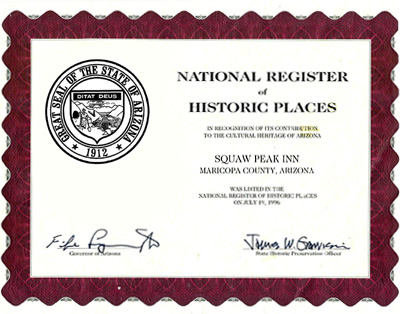Historic Landmark

The structure know as The Historic Squaw Peak Inn had it's beginning
in 1937 when William Almon Stopford and his wife Emily purchased an 800-acre parcel
near the east end of the present-day Phoenix Mountain Preserve for $25.00 an acre.
Originally designed as a home in the center of the parcel for the Stopfords,
by 1943 they had developed it into a guest ranch called the Squaw Peak Ranch.
Mr. Stopford initially built the guesthouse, which is constructed almost entirely
of redwood and consists of a living room, kitchen, three bedrooms, and two baths.
He and his wife Emily lived there while the great house was being built.
Acting as his own architect, Mr. Stopford designed the main home in classic
territorial fashion. Adobe bricks were formed on the site and local Native Americans
formed the primary labor force. The classic adobe architecture is emphasized by
large viga beams and planks, which constitute the roof.
The main house consisted of a great room, dining room, kitchen, and six bedrooms,
each with a private bath. Each room has direct access to the outside, a practical
requirement of the times and as the date of construction preceded modern evaporative
cooling. For three years the Squaw Peak Ranch ran without the luxuries of telephones
or electricity. Kerosene lanterns and an old-fashion icebox were used, and a well
was drilled 395 feet into the hard rock beneath to supply water to the ranch.
In addition to the two central buildings, the Stopfords constructed outbuildings
for domestic help and stables for horses. A short hike along Trail 100 approximately
200 to 300 yards west of the present buildings shows evidence of the remains of
that stable.
According to Mr. Stopford, the early days at his home were primarily characterized
by extreme solitude, interrupted occasionally by visits form his friends, a man
by the name of Frank Lloyd Wright, who lived "out on the flats" (the
desert to the east). Mr. Stopford referred to a number of visits in which Mr.
Wright brought architectural students to point out an example of appropriate architecture
for the Southwest. The only other light visible at night in Paradise Valley was
Mr. Wright's light at Taliesan West.
Visiting Phoenix was also a major event. What is now Tatum Boulevard was at
the time, a very rough dirt road, which meant making the decision to ride a horse
or drive a car, which both took about the same amount of time to transverse the
rough road. Mr. Stopford mentioned that his regular stopping off place was the
Jokake Inn, located just north of what is now the intersection of Camelback and
62nd Street. After a few years a one-lane oil-top road was installed to make the
inn more accessible to guests.
On June 6, 1944, Mr. Stopford sold the home and property to George A. and Patty
D. Judson. The Judsons continued running the guest ranch, with the addition of
slot machines and visits from celebrities as Dick Powell and June Allison. The
Judsons presently own Judson School at Invergordon and Indian Bend in Scottsdale.
In April 1946, the Judsons sold the ranch to Davidson and Jane Trebbing Jenks.
The Jenks had lived on Lincoln Drive near Mountain Shadows and had been familiar
with the guest ranch since its origination. They had moved to Texas with the intention
of ranching the cattle, but oil discovered in the vicinity of the ranch they intended
to buy shot the price of land up beyond there reach. They decided to return to
Phoenix and become guest ranchers instead. "Not too much difference between
guests and cattle, "according to Mr. Jenks, "Ceptin' the guest don't
need branding."
The Jenks decided to remove the slot machines, and added lawns to the west
and east, a putting green, a swimming pool and an L-shaped building to the west
and north of it with five more double rooms and two single rooms, bringing the
ranch's capacity to 30 guests. Quarters for staff were built approximately 250
yards north of the great house and a home was constructed for his mother on the
hillside approximately 150 yards to the northwest. With the exception of the great
house and main home, all additional buildings have been destroyed over the years.
Most of the Judson's staff opted to return to their home ion Ohio from which
they had been recruited, leaving the Jenks to start with nine guests and one girl
to wait table and do maid work. Jane did the cooking until they could hire a cook.
Every Thursday, the Cook's day off, the Jenks would take guests on a day trip,
which cumulated with a cook-out.
Over time, the Squaw Peak Inn became popular "hideaway resort" and,
according to anecdotal reports and newspapers articles, a number of famous persons
were guests. Tradition holds that Clark Gable, Robert Taylor, June Allison, Dr.
William Vaughn, and Mamie Eisenhower have all been guests at the Squaw Peak Inn.
As examples, the plumber who worked on the refurbishing indicated to the present
owner that his father had a picture of himself and Robert Taylor in front of the
building.
A student of the present owner visited for "old time's sake" and
recounted that when he had been a sickly child, his mother had been a waitress
at the Squaw Peak Inn. He fondly remembered "a pretty blonde lady" who
sat and rocked him. It was later that his mother explained to him that the lady
who took such a loving interest in him was June Allison.
Mr. Jenks recalls Mamie Eisenhower's initial visit to the Inn: "In 1960 when
(his daughter) Cathy was five we had with us guests Dr. William Vaughn and his
wife Frances. When one of Frances' friends came to see her, Cathy greeted her
at the front door. 'My name is Cathy. What's yours?' The nice looking lady said,
'Mines Mamie. Is you mother home?' Cathy asked her to come in and escorted her
to the porch. When Jane arrived, she greeted Mamie Eisenhower."
Over the years, Jane began to miss a quiet home-like atmosphere. When Mr. Jenks
was asked if he would consider selling, he "put a fairly good price on it"
and was amazed to be taken up on his offer to sell the by O'Malley Syndicate of
O'Malley Lumber in 1961.
Willis and Margery Betts made a rental agreement with the O'Malleys to continue
operating the inn. The yearly rental agreement was renewed twice then the Betts
gave up.
After the Betts left the inn sat idle for the majority of the years until it
was purchased by the present owners, William and Ann Epley, in 1980. Mr. Jenks,
on occasional visits by the property during this time period recalls, "The
buildings just seemed to be just sitting there. A couple of times I saw people
who seemed to be of the hippy type lounging around the front. I was distressed
to see that all the planting we had done was allowed to die.
On July 1, 1976, Dr. Ted Diethrick purchased the property and made application
to have the present site serve as the centerpiece for the Arizona Heart Institute.
However, this application was with drawn due to highly verbalized oppositions
of neighbors at the time.
The property changed between owners several times before the Malouf Brothers
Industries purchased the property on March 22, 1978. Through the years, portions
of the original 800 acres had been sold off until only a 80-acre parcel remained,
which were purchased by the Malouf Brothers for the purpose of developing a prestigious
residential community, which is now Doubletree Canyon subdivision.
After long negotiations, a parcel just under 2 acres with the two remaining
building were sold to Bill and Ann Epley on October 21,1980. The property borders
the Phoenix Mountain Preserve and historic Trail 100 goes directly behind the
south end of the property.
By the time the Epleys acquired the property, it was in extreme disrepair.
Rattlesnakes, scorpions, rats and black widows had been the only occupants of
the buildings for years and had to be evicted by new owners. Approximately 550
broken planes of glass stared bleakly out at the desert, adding to the once-majestic
inn's now shabby visage. The developer's original intent was to destroy the remaining
building due to their deteriorated condition. There was significant question,
even in the Epleys' minds, whether some portions of the original structure could
be rescued. The most significant structural damage was caused by the water eroding
the sun-dried adobe brick. There were approximately a dozen major factors of the
walls, the most significant along the entire north face of the building.
After long deliberation and consultation with structural engineers, it was
determined the building could be saved. The Epleys have attempted to restore the
building in such a way that the primary historical architecture is retained. The
only significant changes are the modernization of kitchen and bathroom facilities,
which are graced with, potter Ann Epley's handmade ceramic tile, and the addition
of the garage.
The Epley's use of the facilities includes personal residence for themselves
and their children John and Ruth, who are now married. Additionally, the facilities
have been used for numerous weddings, receptions and parties.
The home has been featured repeatedly in television commercials, including
some of the famous Energizer segments featuring Jocko, and for newspaper and magazine
layouts. The home was recently used as a backdrop for an interview with Charles
Barkley of the Phoenix Suns for ABC's Prime Time Live which aired May 27, 1993.
Additionally, the home was the major focal point for the 1987 made-for-TV movie
entitled, "Probe: Plan Nine from Outer Space." Stars of the film included
Parker Stevenson, Michael Constantine, and Mai Britt.

MICKEY & RUTHIE SMITH
4425 E. Horseshoe Road
Phoenix, AZ 85028
(480) 532-0129
Mickey.Smith@LegacyInternational.org
Ruthie.Smith@LegacyInternational.org

Home | About Us | History | Photos | Restoration | Historic Landmark | Recipes | Contact Us
© 2024 The Historic Squaw Peak Inn. All Rights Reserved.
|


